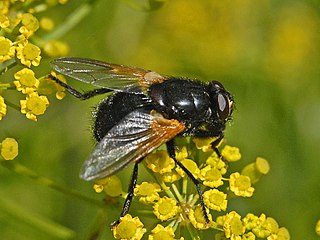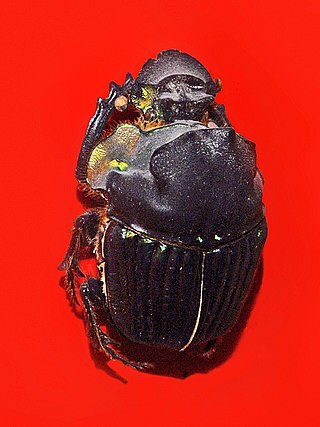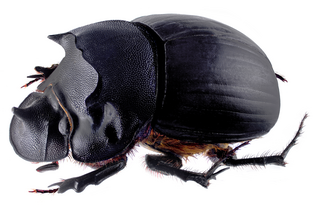
The family Scarabaeidae, as currently defined, consists of over 35,000 species of beetles worldwide; they are often called scarabs or scarab beetles. The classification of this family has undergone significant change in recent years. Several groups formerly treated as subfamilies have been elevated to family rank, and some reduced to lower ranks. The subfamilies listed in this article are in accordance with those in Catalog of Life (2023).

Dung beetles are beetles that feed on feces. Some species of dung beetles can bury dung 250 times their own mass in one night.

Histeridae is a family of beetles commonly known as clown beetles or hister beetles. This very diverse group of beetles contains 3,900 species found worldwide. They can be easily identified by their shortened elytra that leaves two of the seven tergites exposed, and their geniculate (elbowed) antennae with clubbed ends. These predatory feeders are most active at night and will fake death if they feel threatened. This family of beetles will occupy almost any kind of niche throughout the world. Hister beetles have proved useful during forensic investigations to help in time of death estimation. Also, certain species are used in the control of livestock pests that infest dung and to control houseflies. Because they are predacious and will even eat other hister beetles, they must be isolated when collected.

Scarabaeoidea is a superfamily of beetles, the only subgroup of the infraorder Scarabaeiformia. Around 35,000 species are placed in this superfamily and some 200 new species are described each year. Its constituent families are also undergoing revision presently, and the family list below is only preliminary. This superfamily includes some of the largest beetles extant today, including rhinoceros beetles, (Dynastinae), the Hercules beetle and Goliath beetles.

Miller's mastiff bat is a species of bat in the family Molossidae. It is found in Brazil, Colombia, Costa Rica, Guyana, Mexico, Nicaragua, and Venezuela.

The Sinaloan mastiff bat is a species of bat in the family Molossidae, native to Mexico, Central America and northern South America.

Agyrtidae, or primitive carrion beetles, are a small family of beetles belonging to Staphylinoidea. They are found in mostly temperate areas of the Northern Hemisphere and in New Zealand.

Mesembrina meridiana, sometimes known as the noon fly or noonday fly, is a species of fly in the family Muscidae.

Catharsius is a genus of dung beetles in the tribe Coprini in the scarab family.

Heliocopris is a genus of Scarabaeidae or scarab beetles in the superfamily Scarabaeoidea. Forty-seven of the fifty-two known species are found in Africa, but a few are found in southern and southeast Asia.

Meloe violaceus, the violet oil beetle, is a species of oil beetle belonging to the family Meloidae subfamily Meloinae.

Catharsius gorilla is a species of African dung beetles of the family Scarabaeidae. This species is widespread in the tropical African regions.

Diabroctis mimas is a species beetles of the scarab beetle family.

Phanaeus, the rainbow scarabs, is a genus of true dung beetles in the family Scarabaeidae, ranging from the United States to northern Argentina, with the highest species richness in Mexico. Depending on species, they can inhabit a wide range of habitats, from tropical to temperate climates and deserts to rainforests. In those living in relatively arid places adults are primarily active during the wet season and those living in relatively cold places are primarily active during the summer. They are excellent diggers and good fliers.

Teuchestes fossor is a species of dung beetle native to the Palaearctic, but is also widespread in North America following accidental introduction and naturalisation during European settlement. Both adults and larvae are coprophagous, differentiating resource use by respectively feeding on the liquid and fibrous fractions of herbivore dung. It can be readily collected from the dung of livestock, and other large mammals This species is known to support a number of key ecosystem services in cattle pastures.

Coprini is a tribe of scarab beetles, in the dung beetle subfamily (Scarabaeinae). Scholtz et al. describe them as tunnellers that are shiny black, of moderate to large size and with a strongly convex shape. They also, however state that the grouping based on these characteristics has little phylogenetic validity, and the placement of several genera in this and related tribes is likely to change.
Catharsius capucinus, is a species of dung beetle found in India, Sri Lanka, Bangladesh and Nepal.

Catharsius granulatus, is a species of dung beetle found in India, Pakistan, Sri Lanka, Afghanistan, Nepal, Sikkim, China, Taiwan, Andaman Islands, Vietnam, Laos, Cambodia, Thailand, Malaysia, and Sunda Islands.

Catharsius pithecius, is a species of dung beetle found in India, Sri Lanka, Pakistan and China.

Gymnopleurus sericeifrons, is a species of dung beetle found in Afro-tropical countries such as Mozambique, Kenya, India and Sri Lanka.



















